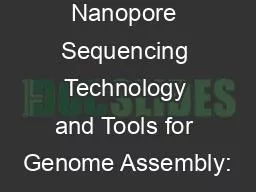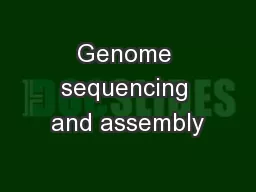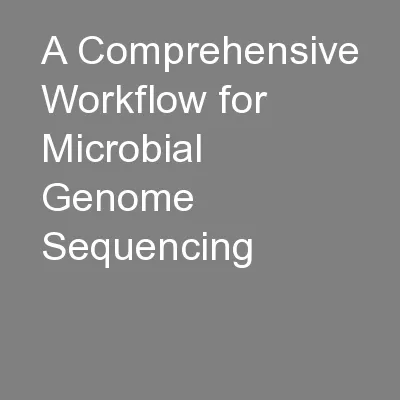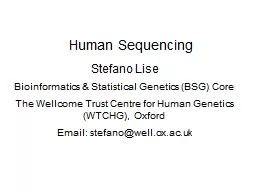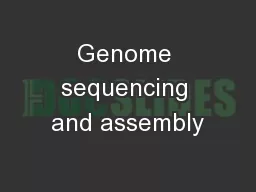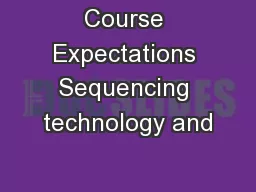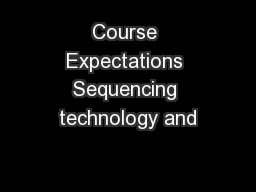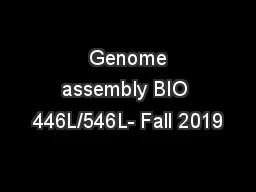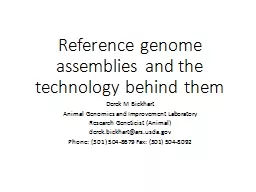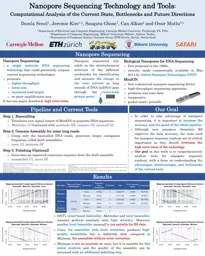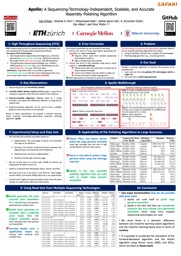PPT-Nanopore Sequencing Technology and Tools for Genome Assembly:
Author : fluental | Published Date : 2020-08-28
Computational Analysis of the Current State Bottlenecks and Future Directions Damla Senol Cali 1 Jeremie S Kim 13 Saugata Ghose 1 Can Alkan 2 and Onur Mutlu 31
Presentation Embed Code
Download Presentation
Download Presentation The PPT/PDF document "Nanopore Sequencing Technology and Tools..." is the property of its rightful owner. Permission is granted to download and print the materials on this website for personal, non-commercial use only, and to display it on your personal computer provided you do not modify the materials and that you retain all copyright notices contained in the materials. By downloading content from our website, you accept the terms of this agreement.
Nanopore Sequencing Technology and Tools for Genome Assembly:: Transcript
Computational Analysis of the Current State Bottlenecks and Future Directions Damla Senol Cali 1 Jeremie S Kim 13 Saugata Ghose 1 Can Alkan 2 and Onur Mutlu 31 Nanopore Sequencing. sequencing . for . identification,. detection, . and control of . Bactrocera dorsalis (. Hendel. ). and other Tephritid pests. Thomas Walk, Scott . Geib. USDA-ARS Pacific Basin Agricultural Research Center, Hilo HI. Mayo/UIUC Summer . C. ourse in Computational Biology. Session Outline. Genome sequencing. Schematic overview of genome assembly. (a) DNA is collected from the biological sample and sequenced. (b) The output from the sequencer consists of many billions of short, unordered DNA fragments from random positions in the genome. (c) The short fragments are compared with each other to discover how they overlap. (d) The overlap relationships are captured in a large assembly graph shown as nodes representing . From Swab to Publication. Madison I. Dunitz. 1. , David A. Coil. 1. , Jenna M. Lang. 1. , Guillaume Jospin. 1. , Aaron E. Darling. 2. , Jonathan A. Eisen. 1. UC Davis Genome Center. 1. University of California, Davis; . Dan . Russell. The past, present, and future of DNA . sequencing*. Dan . Russell. *DNA sequencing:. D. etermining the number and order of nucleotides that make up a given molecule of DNA.. (Relevant) Trivia. Stefano . Lise. Bioinformatics & Statistical Genetics (BSG) Core. The . Wellcome. Trust Centre for Human Genetics (WTCHG), Oxford. Email: stefano@well.ox.ac.uk. Outline. Human genetic variation in health and disease. Mayo/UIUC Summer . C. ourse in Computational Biology. Session Outline. Genome sequencing. Schematic overview of genome assembly. (a) DNA is collected from the biological sample and sequenced. (b) The output from the sequencer consists of many billions of short, unordered DNA fragments from random positions in the genome. (c) The short fragments are compared with each other to discover how they overlap. (d) The overlap relationships are captured in a large assembly graph shown as nodes representing . Lenka Veselovská. Laboratory of Developmental Biology and Genomics . Next Generation Sequencing (NGS) . M. odern high-throughput DNA sequencing technologies. parallel, rapid . Decreasing price, time, workflow complexity, error rate. (very) large datasets. 5/23/17. Goals for the course. Understand how next-generation sequencing technologies are used in biomedical research. Learn how to use publicly available databases/websites to find specific information about genes. for Colorectal . Cancer. Ulrike (. Riki. ) Peters. Fred Hutchinson Cancer Research Center. University of Washington. Overview. Significance and rationale. . Current efforts on rare and less frequent variants. (very) large datasets. 5/24/18. Goals for the course. Understand how next-generation sequencing technologies are used in biomedical research. Learn how to use publicly available databases/websites to find specific information about genes. Purbendra yogi. Introduction. Genome assembly is the process of taking of many short DNA sequences and combine them to form original chromosome.. First generation Assembly began in the late 1980’s and early 1990’s.. Derek M Bickhart . Animal Genomics and Improvement Laboratory . Research Geneticist (Animal) . derek.bickhart@ars.usda.gov . Phone: (301) 504-8679 Fax: (301) 504-8092. USDA disclaimer. Disclaimers: Mention of trade names, commercial products, or companies in this publication is solely for the purpose of providing specific information and does not imply recommendation or endorsement by the US Department of Agriculture over others not mentioned. . :. Computational Analysis of the Current State, Bottlenecks and Future Directions. Damla Senol. 1. , Jeremie . Kim. 1,3. , . Saugata Ghose. 1. , Can Alkan. 2. and Onur Mutlu. 3,1. 1 . Department of Electrical and Computer Engineering, Carnegie Mellon University, Pittsburgh, PA, USA. and Accurate Assembly Polishing Algorithm. Can Firtina. 1. , Jeremie S. Kim. 1,2. , Mohammed Alser. 1. , . Damla. . Senol. Cali. 2. , A. . Ercument. Cicek. 3. ,. Can Alkan. 3. , and . Onur. Mutlu.
Download Document
Here is the link to download the presentation.
"Nanopore Sequencing Technology and Tools for Genome Assembly:"The content belongs to its owner. You may download and print it for personal use, without modification, and keep all copyright notices. By downloading, you agree to these terms.
Related Documents

